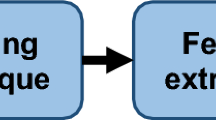Abstract
Today, auscultation is one of the most effective methods in monitoring heart disease. With the advancement of technology and the facilitation of telecare on the one hand, and the increasing need for high quality and long-term recording of cardiac audio signals on the other hand, the amount of data generated has increased and therefore, the storage and transmission of these signals has become a challenge. This, in turn, demonstrates the importance and necessity of using efficient methods for compression of these signals. These methods should have a high compression ratio and, at the same time, preserve important clinical information as much as possible. In this paper, a lossy compression method is proposed for phonocardiography (PCG) signals recorded at a relatively high sampling rate so that it can control the quality of the compressed signal. This method is based on two techniques: "two-stage downsampling" and "pattern matching (PM)". The proposed two-stage downsampling technique increases the amount of compression ratio and at the same time, reduces the computational complexity. The PM technique is able to reduce the inter-period redundancy and therefore, further increase the compression ratio. The simulation results of the proposed method on two databases of the University of Michigan and the University of Washington showed that the two-stage downsampling and PM techniques have a large contribution in increasing the compression ratio. The performance of the proposed method was evaluated according to the PRD and CR criteria and compared with that of some existing methods. In this evaluation, for the PRD range of ≤5%, the CR value was between 2500 and 3900 for the University of Michigan database and between 2500 and 4125 for the University of Washington database. Also, the results of applying the proposed method on the PASCAL database showed that the efficiency of the proposed method depends to a large extent, on the quality and regularity of the PCG signal.










Similar content being viewed by others
Notes
Percentage Root-mean-square Difference
References
Aggarwal V, Gupta S, Patterh MS, Kaur L (2020) Analysis of compressed foetal Phono-Cardio-Graphy (PCG) signals with discrete cosine transform and discrete wavelet transform. IETE J Rese. https://doi.org/10.1080/03772063.2020.1725662
Alajarin JM, Candel JL, Merino RR (2006) ASEPTIC: Aided system for event-based phonocardiographic telediagnosis with integrated compression. 2006 Computers in Cardiology, Valencia, Spain, 17–20
Alajarin JM, Guerrero JG, Merino RR (2007) Optimization of the compression parameters of a phonocardiographic telediagnosis system using genetic algorithms. In: Mira J., Álvarez J.R. (eds) Bio-inspired Modeling of Cognitive Tasks. IWINAC pp 508–517 June 2007. Lecture Notes in Computer Science, vol 4527. Springer, Berlin, Heidelberg
Aljarin JM, Merino RR (2004) Wavelet and wavelet packet compression of phonocardiograms. Electronic Letters 40(17):1040–1041
Bendifallah A, Boulemden M, Benzid R (2015) Bitmask and SPIHT based PCG signal compression, 2015 4th International Conference on Electrical Engineering (ICEE), 13–15 Dec. Boumerdes, Algeria
Bentley P et al. PASCAL Classifying heart sounds challenge (2011). http://www.peterjbentley.com/heartchallenge/. Accessed 1 Apr 2021
Boukhennoufa N, Benmahammed K, Benzid R (2012) Effective PCG signals compression technique using an enhanced 1-D EZW. International Journal of Advanced Science and Technology 48:89–102
Burger W, Burge MJ (2009) Principles of digital image processing: core algorithms. Springer, London
Chien Y-R, Hsu K-C, Tsao H-W (2020) Phonocardiography signals compression with deep convolutional autoencoder for telecare applications. Appl Sci 10(17):5842
Chowdhury M, Poudel K, Hu Y (2018) Phonocardiography data compression using discrete wavelet transform, 2018 IEEE Signal Processing in Medicine and Biology Symposium (SPMB), Philadelphia, PA, USA, 1–1
http://depts.washington.edu/physdx/heart/demo.html. Accessed 1 Apr 2021.
http://www.med.umich.edu/lrc/psb_open/html/repo/primer_heartsound/primer_heartsound.html. Accessed 1 Apr 2021.
Kim S, Hwang D (2016) Murmur-adaptive compression technique for phonocardiogram signals. IEEE Electronics Letters 52(3):183–184
Manikandan MS, Dandapat S (2007) Wavelet-Based ECG and PCG signals compression technique for mobile telemedicine. 15th International Conference on Advanced Computing and Communications (ADCOM 2007), pp. 164–169, Guwahati, India, 18–21
Manikandan MS, Soman KP, Dandapat S (2011) Quality-driven wavelet based PCG signal coding for wireless cardiac patient monitoring, Proceedings of the 1st International Conference on Wireless Technologies for Humanitarian (ACWR 2011), pp. 519-526, Amritapuri, 2011
Patidar S Pachori RB (2016) Tunable-Q wavelet transform based optimal compression of cardiac sound signals, 2016 IEEE Region 10 Conference (TENCON), pp 2193–2197, 10.1109/TENCON.2016.7848416
Qin W Wang P (2013) A remote heart sound monitoring system based on LZSS Lossless Compression Algorithm. 2013 IEEE 4th International Conference on Electronics Information and Emergency Communication, Beijing, China, 15–17
Said A, Pearlman WA (1993) Image compression using the spatial-orientation tree, in Proceedings of the IEEE International Symposium Circuits and Systems, pp. 279–282
Said A, Pearlman WA (1996) A new, fast, and efficient image codec based on set partitioning in hierarchical trees. IEEE Transactions on Circuits Systems and Video Technology 6(3):243–250
Shapiro JM (1993) Embedded image coding using zerotrees of wavelet coefficients. IEEE Transactions on Signal Processing 41(12):3445–3462
Stark H-G (2005) Wavelets and signal processing: An application-based introduction. Springer, Berlin Heidelberg
Stoica P, Moses R (2005) Spectral analysis of signals. Prentice Hall, Upper Saddle River, NJ
Subasi A (2019) Practical guide for biomedical signals analysis using machine learning techniques: A MATLAB Based Approach, Academic Press
Tang H, Zhang J, Sun J, Qiu T, Park Y (2016) Phonocardiogram signal compression using sound repetition and vector quantization. Computers in Biology and Medicine 71:24–34
Author information
Authors and Affiliations
Corresponding author
Ethics declarations
Conflict of interest
The authors have no competing interests to declare that are relevant to the content of this article.
Additional information
Publisher’s note
Springer Nature remains neutral with regard to jurisdictional claims in published maps and institutional affiliations.
Rights and permissions
Springer Nature or its licensor (e.g. a society or other partner) holds exclusive rights to this article under a publishing agreement with the author(s) or other rightsholder(s); author self-archiving of the accepted manuscript version of this article is solely governed by the terms of such publishing agreement and applicable law.
About this article
Cite this article
Grailu, H. Compression of high-sampling-rate heart sound signals based on downsampling and pattern matching. Multimed Tools Appl 83, 201–226 (2024). https://doi.org/10.1007/s11042-023-15714-1
Received:
Revised:
Accepted:
Published:
Issue Date:
DOI: https://doi.org/10.1007/s11042-023-15714-1




